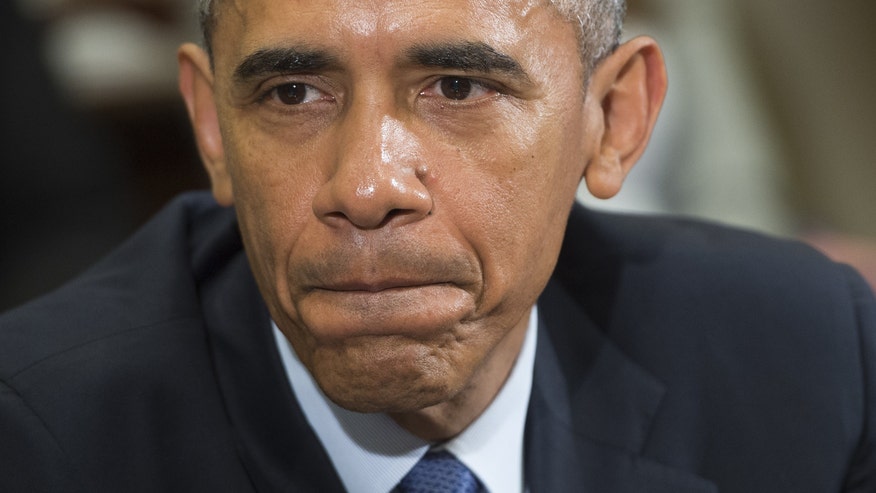2/6/2015

source

US President Barack Obama. (Photo: SAUL LOEB/AFP/Getty Images)
The Obama administration is pulling the plug on a stimulus-backed “clean coal” power plant in central Illinois that was supposed to play a key support role for a proposed regulation to mandate carbon capture technology for coal plants.
The Energy Department announced it was pulling funding for the FutureGen 2.0 power plant after awarding project developers $1.1 billion as part of the 2009 stimulus package — most of the awarded funds were never spent.
“In order to best protect taxpayer interests, the Department of Energy has initiated a structured closeout of federal support for the project that will help maximize the value of investments to date while minimizing ongoing risks and further costs,” said DOE spokesman Bill Gibbons.
The DOE’s dismantling of the project is a huge blow to the Obama administration’s climate agenda, mainly because FutureGen’s failure undermines pending rules mandating coal plants use carbon capture and storage (CCS) technology. Obama was hoping to use FutureGen to show that CCS was commercially viable, a point that the coal industry has been contesting.
“The Obama Administration is engaging in misleading double-talk on clean coal technology. Although the administration leaned heavily on FutureGen technologies to justify its flawed New Source Performance Standards rule,” said Laura Sheehan, spokeswoman for the American Coalition for Clean Coal Electricity.
“President Obama has now cut the project off altogether—demonstrating his hypocrisy towards the American people and his bias against advanced clean coal technologies,” Sheehan said.
FutureGen 2.0 was started in 2003 under former President George W. Bush as a public-private partnership to develop CCS. The project was heavily supported by federal lawmakers, including then Sen. Obama in 2006. But the project hit major hurdles and was subsequently restarted under President Obama with stimulus funds.
Under Obama, the clean coal plant was meant to justify a 2013 Environmental Protection Agency rule that limits the amount of carbon dioxide emissions that can be emitted by new coal-fired power plants. EPA set emissions limits so low that even the most efficient coal plants could not meet them without installing CCS technology.
Power companies, however, argued that CCS was an unproven technology. No commercial-scale power plant uses CCS, and the only CCS projects in existence aren’t producing commercial power and are backed by the federal government.
CCS technology is supposed to trap a certain percentage of the carbon dioxide emissions in power plants burning coal or natural gas. These emissions
Republican lawmakers and the coal industry have said EPA’s CCS mandate violates the Environmental Policy Act of 2005 which prohibits the government from mandating technologies that are being federally subsidized.
The EPA, however, says CCS is a commercially proven technology,citing several government-backed projects across the U.S., including FutureGen 2.0. EPA said a “larger scale project—the FutureGen 2.0 Project—is in advanced stages of planning in the U.S.” in its proposed global warming rule. The rule was published a little more than a year ago.
Just months ago, the EPA even gave FutureGen 2.0 permission to store carbon dioxide underground. But even then the project’s CEO Ken Humphreys said complaints against the project by state regulators and environmental groups had hampered their ability to raise money.
“FutureGen 2.0 is the only project in the world that demonstrates oxy-combustion technology and fully integrates deep saline geographic storage,” Humphreys said after the DOE announced it would pull funding for the project. “Our hope is that industry and government will continue to find ways to develop (carbon capture and storage) technology for a cleaner, more secure energy future.”
“FutureGen’s goal is to capture and inject 1.1 million metric tons of carbon dioxide each year for 20 years,” EPA said in September. “Sequestering 1.1 million metric tons of carbon dioxide each year is the equivalent of eliminating carbon emissions from 232,000 cars.”
News of FutureGen’s demise comes as Obama requests $560 million from Congress to fund CCS research. Interestingly enough, DOE cited FutureGen 2.0 as an example of the progress it had made on CCS deployment.
“President Obama and his federal agencies are clearly opposed to advancing carbon capture and storage technology, despite repeated assurances,” Sheehan said. “What makes this action even more disgraceful is then-Senator Obama’s full-throated support for FutureGen in 2006.”
source
No comments:
Post a Comment